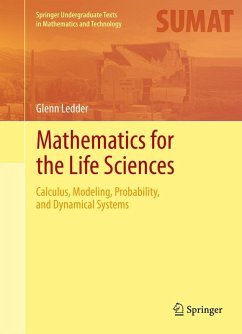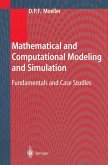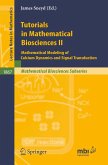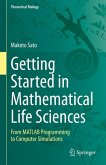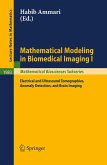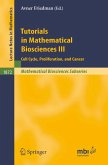Mathematics for the Life Sciences provides present and future biologists with the mathematical concepts and tools needed to understand and use mathematical models and read advanced mathematical biology books. It presents mathematics in biological contexts, focusing on the central mathematical ideas, and providing detailed explanations. The author assumes no mathematics background beyond algebra and precalculus. Calculus is presented as a one-chapter primer that is suitable for readers who have not studied the subject before, as well as readers who have taken a calculus course and need a review. This primer is followed by a novel chapter on mathematical modeling that begins with discussions of biological data and the basic principles of modeling. The remainder of the chapter introduces the reader to topics in mechanistic modeling (deriving models from biological assumptions) and empirical modeling (using data to parameterize and select models). The modeling chapter contains a thorough treatment of key ideas and techniques that are often neglected in mathematics books. It also provides the reader with a sophisticated viewpoint and the essential background needed to make full use of the remainder of the book, which includes two chapters on probability and its applications to inferential statistics and three chapters on discrete and continuous dynamical systems.
The biological content of the book is self-contained and includes many basic biology topics such as the genetic code, Mendelian genetics, population dynamics, predator-prey relationships, epidemiology, and immunology. The large number of problem sets include some drill problems along with a large number of case studies. The latter are divided into step-by-step problems and sorted into the appropriate section, allowing readers to gradually develop complete investigations from understanding the biological assumptions to a complete analysis.
The biological content of the book is self-contained and includes many basic biology topics such as the genetic code, Mendelian genetics, population dynamics, predator-prey relationships, epidemiology, and immunology. The large number of problem sets include some drill problems along with a large number of case studies. The latter are divided into step-by-step problems and sorted into the appropriate section, allowing readers to gradually develop complete investigations from understanding the biological assumptions to a complete analysis.
Dieser Download kann aus rechtlichen Gründen nur mit Rechnungsadresse in A, B, BG, CY, CZ, D, DK, EW, E, FIN, F, GR, HR, H, IRL, I, LT, L, LR, M, NL, PL, P, R, S, SLO, SK ausgeliefert werden.
From the book reviews:
"The exposition is very clear and detailed with a large number of carefully selected examples and exercises based on the material familiar to biologists. An excellent choice for the lecturer interested in designing a 2-course sequence of 4-credit courses covering almost the entire book, a 2-course sequence of 3-credit calculus-for-biology courses for students with no calculus background, or a 3-credit calculus-for-biology course with selected material." (Svitlana P. Rogovchenko, zbMATH, Vol. 1302, 2015)
"The author's aim here is to give students enough experience with mathematical modeling that they can read and appreciate scientific work with mathematical content. ... Throughout the book the author includes case studies in his problem sets that continue and develop as new material from the text is introduced. ... This is a clearly written text that is sensitive to the needs and capabilities of life science students." (William J. Satzer, MAA Reviews, August, 2014)
"This is an ideal text for novice students, enabling them to learn techniques that have immediate applicability. ... Summing Up: Highly recommended. Lower-division undergraduates." (P. Cull, Choice, Vol. 51 (11), August, 2014)
"This book is written with the intention 'to help biologists bridge the gap between the mathematics they already know and what they need to know to read advanced books' and the book accomplishes this task very well. ... the book is of good help for undergraduate and graduate students in Biomedical Engineering as well as other disciplines such as Electrical Engineering. The book, coming with a solutions manual and software, will prove to be an excellent choice for textbook for undergraduate level ... ." (D. Subbaram Naidu, Amazon.com, November, 2013)
"The exposition is very clear and detailed with a large number of carefully selected examples and exercises based on the material familiar to biologists. An excellent choice for the lecturer interested in designing a 2-course sequence of 4-credit courses covering almost the entire book, a 2-course sequence of 3-credit calculus-for-biology courses for students with no calculus background, or a 3-credit calculus-for-biology course with selected material." (Svitlana P. Rogovchenko, zbMATH, Vol. 1302, 2015)
"The author's aim here is to give students enough experience with mathematical modeling that they can read and appreciate scientific work with mathematical content. ... Throughout the book the author includes case studies in his problem sets that continue and develop as new material from the text is introduced. ... This is a clearly written text that is sensitive to the needs and capabilities of life science students." (William J. Satzer, MAA Reviews, August, 2014)
"This is an ideal text for novice students, enabling them to learn techniques that have immediate applicability. ... Summing Up: Highly recommended. Lower-division undergraduates." (P. Cull, Choice, Vol. 51 (11), August, 2014)
"This book is written with the intention 'to help biologists bridge the gap between the mathematics they already know and what they need to know to read advanced books' and the book accomplishes this task very well. ... the book is of good help for undergraduate and graduate students in Biomedical Engineering as well as other disciplines such as Electrical Engineering. The book, coming with a solutions manual and software, will prove to be an excellent choice for textbook for undergraduate level ... ." (D. Subbaram Naidu, Amazon.com, November, 2013)

